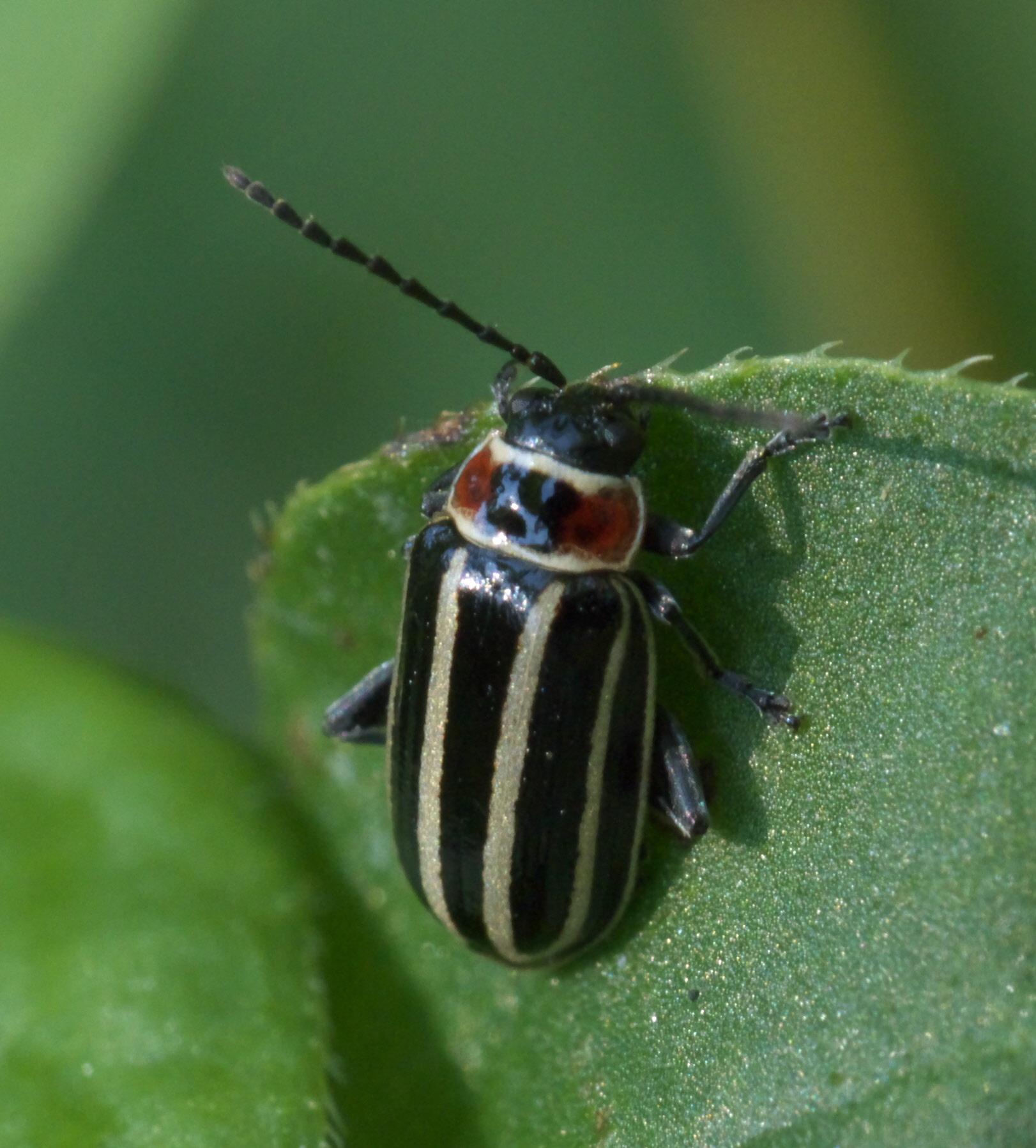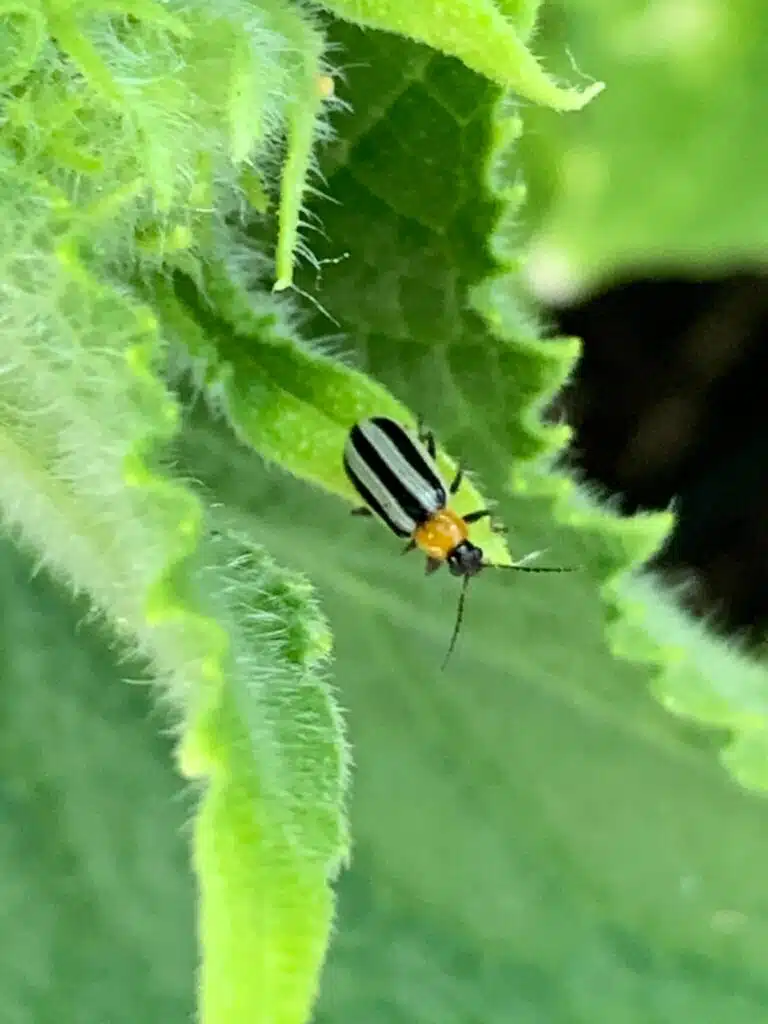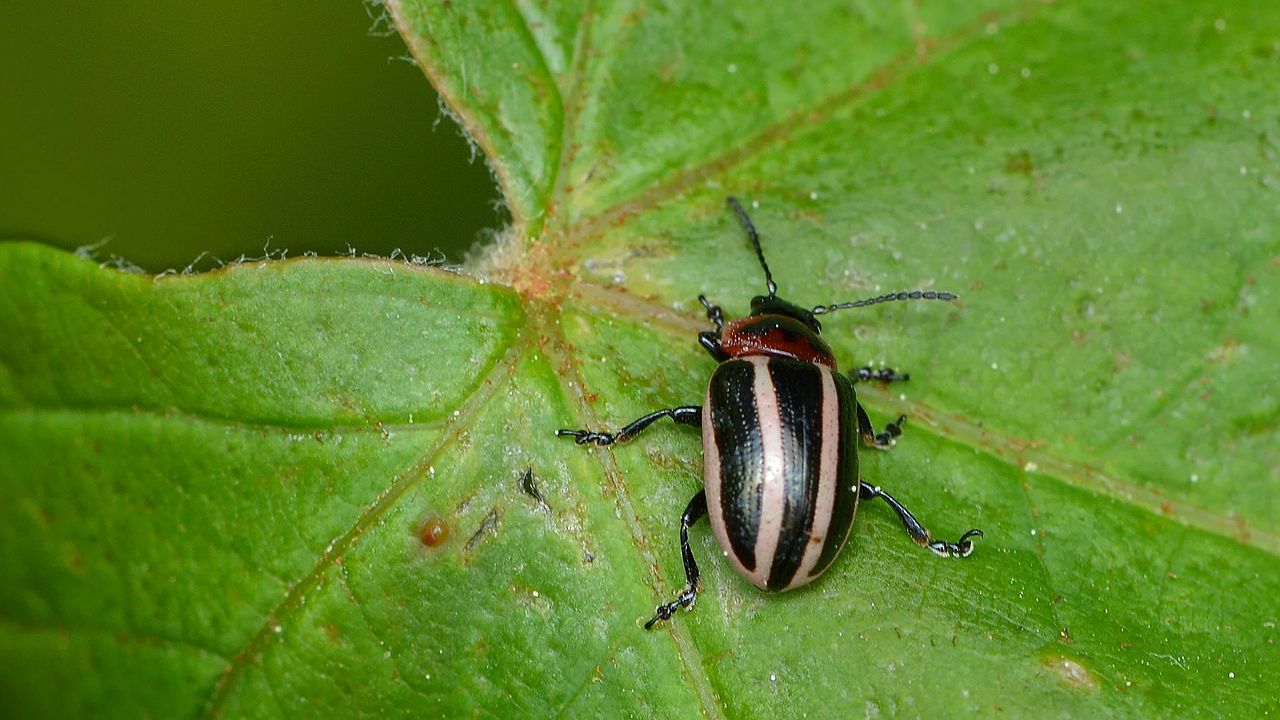Forests, prairies, beaches, and deserts are among the multiple habitats where black bugs with white stripes can be found.
These types of bugs are known to stand out. With or without wings, they can be black and white at different stages of their lives or throughout their various life stages.
The number, shape, and size of stripes can vary. From black to white stripes, the following species can be seen in at least one color pattern.
Here are some of the typical species of black bugs that show a varying number of white stripes.
Table of Contents
1. Pigweed Flea Beetle
4 stripes dominate the appearance of The Pigweed Flea Beetle (Disonycha glabrata). There are 2 wider stripes on the inner wings and 2 wide stripes on the out wings of the bugs.

Sometimes white, these types of stripes are highly variable in appearance. They can also be yellow, golden-yellow, and even tan.
The rest of its appearance is dominated by black ground color and a brown prothorax.
The species is seen on pigweed.
It also uses the plant to lay eggs. Emerging Pigweed Flea Beetle spends just a few days on the plant before dropping on the ground and fully developing the ground.
Number of stripes – 4
2. Pennsylvania Flea Beetle

A similar species to Pigweed Flea Beetles, Pennsylvania Flea Beetles (Disonycha pensylvanica) may also come with white stripes.
One of the ways to these 2 species apart is by their habitat. Pennsylvania Flea Beetles are fans of wetlands, where they eat vegetation.
These bugs also have a black ground color while their stripe varies from white to cream or yellow nuances.
A brown-red pronotum and a black head are specific to these stand-out bugs.
Like Pigweed Flea Beetles, these bugs also show a black mark on the brown pronotum.
Number of stripes – 4
3. Western Striped Cucumber Beetle

Flowers, fruit, and leaves of cucumbers and pumpkins are among the impacted species of Western Striped Cucumber Beetles (Acalymma trivittatum).
Squash, zucchini, and other cucurbits are impacted by these stripes bugs.
A bright ground color is specific to the bugs. Black stripes contrast its bright appearance and make it a similar species to other bugs with stripes.
The wide black stripes of the species make it look like the bug has additional white stripes alternating between the black stripes.
Bugs of the species can be problematic for crops but predators such as harvestmen typically help control possible outbreaks.
Number of stripes – 3
4. Ragweed Leaf Beetle

4 main white stripes are seen across the elytra of the Ragweed Leaf Beetle (Zygogramma suturalis).
This species has a brown ground color, a black ground color, or a red-brown ground color. Its contrasting stripes can be white, yellow, tan, or cream.
In some cases, Ragweed Leaf Beetle has 4 wide white stripes and 2 narrow white stripes.
This is a species with global distribution. A bug introduced for the control of ragweed, the beetle even has a brighter stage, as a juvenile.
At this stage, it’s white that dominates its elytra.
Number of stripes – 4 – 6
5. Cottonwood Borer

A combination of white stripes and white bands make up the bright pattern of The Cottonwood Borer (Plectrodera scalator).
A black base color is specific to the species. Its prothorax and elytra are all black, together with the legs and antennae.
White sections are seen on the species soon after it emerged from its larval stage, a period also spend underground.
Feeding on some of the youngest trees and plants, these types of bugs appear in early summer.
Number of stripes – variable
6. Coreopsis Beetle

4 white stripes can contrast the black appearance of Coreopsis Beetles (Calligrapha californica). This is a species with full or interrupted stripes.
Some of the stripes most likely to be interrupted are those of the mid-dorsum while the stripes at the sides are full.
The width of the stripes may also vary, together with their colors.
Some other colors Coreopsis Beetle stripes are seen in also include pink, green, metallic green, purple, yellow, and tan.
Number of stripes – 4
7. Banded Alder Borer

White horizontal stripes are seen on the black Banded Alder Borer (Rosalia funebris).
This is a bug with wide white bands which are seen across its wings, prothorax, and antennae.
A species that feeds on alder and wood, Banded Alder Borers aren’t seen as a major threat in Canada and The United States.
One of the main reasons for its low impact compared to other wood borers is the change in the diet of adults as opposed to larvae.
Adult bugs of the species feed on flowers. They are also identified by a squeak-like noise.
Number of stripes – 3
8. Spruce Zebra Beetle

Named after its most common coniferous host, spruce, this type of beetle (Xylotrechus undulatus) is identified by its contrasting appearance.
A black ground color is characteristic of the species. White stripes and bands are further seen on its wings.
Interrupted U-shaped bands are seen across its wings. Additional white dots may be further spotted between its stripes.
The prothorax of the species shows an additional white stripe, interrupted right behind the head.
Spruce Zebra Beetles are specific to the Northwestern and Western US states.
Number of stripes – 4
9. American Sand Wasp

A species of The Americas, The American Sand Wasp (Bembix americana) has widespread distribution along coastlines.
This is a species of predatory wasps. It feeds on other insects which it also provisions to its young.
Unlike other black and yellow wasps, The American Sand Wasp has black and white coloring.
5 white wide stripes are seen on the abdomen of this wasp.
The pattern of the stripes is wavy while the first stripe close to the thorax has an interrupted central section.
These wasps also have dual-colored green and yellow eyes.
Number of stripes – 5
10. Bald-faced Hornet

Bald-faced Hornets (Dolichovespula maculata) are among the most common species of wasps in North America.
It even comes with several white stripes and patterns across its body.
There are 3 white stripes at the tip of the abdomen. Bald-faced Hornets also have a white abdomen tip as well as additional white patterns behind the head.
Additional white patterns are seen on its face.
These wasps can be aggressive, especially when their nests are threatened. Some Bald-faced Hornet casts can sting multiple times.
Number of stripes – 3
11. White-bowed Smoothwing

6 white stripes with curved ends are seen on the abdomen of The White-bowed Smoothwing (Scaeva affinis).
This is a species that may even be taken as a hoverfly with 3 interrupted stripes to their symmetrical arrangement on each side of the abdomen.
The tip of its abdomen is also white.
White-bowed Smoothwings may have brown or black and white heads.
One of the atypical traits of these hoverflies is they may also show white ventral stripes.
Number of stripes – 6
12. Oak Treehopper

6 white horizontal stripes are seen on the adult Oak Treehopper (Platycotis vittata). An additional white vertical stripe crosses its mid-dorsum.
White stripes also contour its head.
A variable appearance treehopper, The Oak Treehopper may or may not show colorful stripes in its nymph stage.
A minor pest on trees, Oak Treehoppers cause the most damage in their larval stage.
They can be spotted on trees around Florida.
Number of stripes – variable
13. California Digger-cuckoo Bee

A species of North America, this type of bee (Brachymelecta californica) comes with 5 interrupted stripes on its abdomen.
These white stripes are wide and contrasted by the black ground color. Its thorax and head are also black.
California Digger-cuckoo Bees have slightly transparent wings with visible black veins.
Mostly active from June to October, this bee also stands out with its pale hairs.
These pale hairs are seen along its body and are different from the gray-brown or black hairs seen on other bees.
Number of stripes – 5 stripes on each side of the abdomen
14. Texas Leaf-cutter Bee

A similar pattern of white stripes to those seen on The California Digger-cuckoo Bee is seen on The Texas Leaf-cutter Bee (Megachile texana).
5 stripes are seen on its black abdomen. These stripes aren’t interrupted as on The California Digger-cuckoo Bee.
This species also has smoky wings of a dark brown color with dark brown veins.
Growing to a size of up to 0.5 inches, Texas Leaf-cutter Bees nest in the ground.
They prefer nests in sheltered areas such as behind trees, logs, or rocks.
Unlike other ground-nesting bees, Texas Leaf-cutter Bees dig long nests of up to 10 inches.
Number of stripes – 5
15. White-striped Tiger Beetle

White, yellow, tan, or cream stripes are seen on The White-striped Tiger Beetle (Jundlandia lemniscata).
Living in a habitat from California to Texas, this bug has a metallic red-brown base color.
Found in the deserts of The South-White-striped Tiger Beetles may also come in slightly different ground nuances.
These include brown, brown-green, and yellow-brown ground colors of a metallic nuance.
Number of stripes – 2
Further Readings: